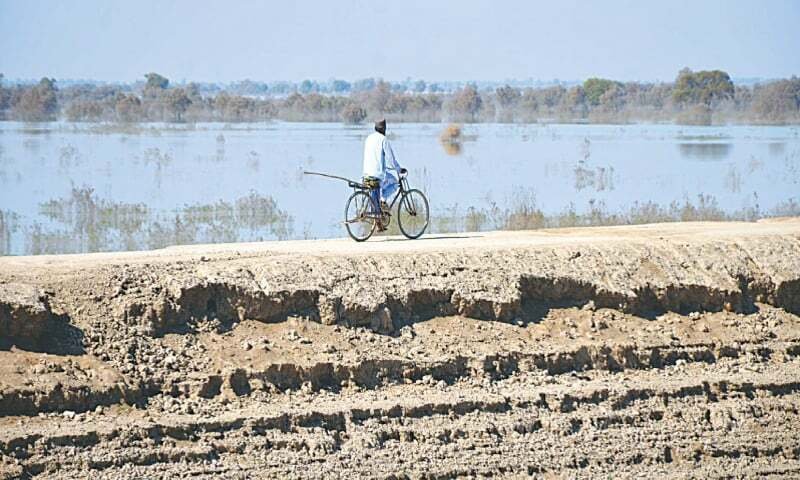December 20, 2022
ISLAMABAD – An elderly Ghulam Shabbir was riding on his worn-out bicycle to reach his family members at Main Nara Valley Drain (MNVD) in Johi, as a road from Rodhnani Mori over the drain to link the area with Chinni remains disconnected owing to floodwater.
“The local community had made cuts on the road to let floodwaters pass from their villages towards MNVD in order to divert the flow of water to Manchhar lake,” Mr Shabbir explained to Dawn during a recent visit to Johi.
Multiple cuts were observed on the road with water flowing at a considerable speed, indicating that a big quantum of water has yet to pass from the affected villages located in UCs Chinni and Kamal Khan, as pointed out by Ghulam Rasool, a resident of the area.
“This road goes to Gaji Shah and is also connected with Kachho,” he said. He looked depressed for having lost last year’s grain to gushing floodwaters from upper Balochistan. “Winter has already started to test us. The land in my village is underwater. Water from UC Kamal Khan is entering our UC [union council] and these four cuts are acting as recourse to dewater our areas,” he said, adding that waist-deep water was still there in the village.
Johi is a taluka located in Dadu district, where Khairpur Nathan Shah and Mehar talukas were worst affected by the floods. While Johi city, fortunately, remained safe during the flooding after locals put up a brave face to floodwater by strengthening the old levee of an irrigation channel, several parts are still underwater.
Parts of Dadu remain inundated; villagers start reconstruction of houses amid delay in govt aid
“Considerable parts of Johi are cleared now. Some pockets or villages are underwater causing disconnectivity,” said Mukhtiar Ali Babbar, a political activist from Johi. However, road links with major cities upstream, including Sehwan, have long been restored through the Indus Highway.
As many areas are cleared now, the survivors await the promised financial aid for the reconstruction of their houses lost to floods.
As per Sindh Chief Secretary Dr Mohammad Sohail Rajput — who spoke at length about devastations caused by calamitous floods before Sindh High Court — at least 2.2 million mudhouses were lost as a result of flooding.

JOHI: A man is on his way back to his village on cycle.
“A cumulative cost of $1.5bn housing is assessed. It is indeed a huge amount but thanks to the foreign minister’s initiative the Pakistan government is holding a donors’ conference in Geneva next month to get necessary support [for rehabilitation],” he said.
“We conducted a door-to-door survey in collaboration with armed forces which revealed that 2.2m katcha houses were destroyed. Sindh has three million [katcha] houses according to a Unicef-sponsored survey of 2019,” he said.
Since the government aid will arrive after the ‘codal formalities’, the residents have taken it upon themselves to rebuild their houses. “At least Rs150,000 are being spent to rebuild a room of my house and we sold goats to have that kind of money,” said Ghulam Shabbir, an adult in village Mohammad Hassan Nohani in union council Jhangara, a constituency of the Sindh CM in Sehwan.
Ten union councils were badly hit by floodwaters that swept away mudhouses after Manchhar lake’s dykes had to be breached in September to ease pressure on the lake.
Shabbir’s father, who knows masonry, was busy re-constructing another room. In the absence of tents, five households were living in mere four rooms. “We didn’t get tents when we needed that and now we are trying to save money by doing this laborious work,” he said, standing next to the rubble of his house. He doesn’t know when the government is going to provide him the financial aid for reconstruction, but he couldn’t wait for long. “With the expenditure of Rs300,000, we will be able to build two rooms and a veranda at least,” he said, confirming that government teams had visted his village for the survey of damages.
Sehwan taluka’s 10 union councils faced deluge in the wake of Sept 4 and 5 relief cuts in Manchhar lake’s embankment that entered the Indus river through the Larkana-Sehwan dyke, also breached at four locations. Floodwaters have receded from substantial parts of Sehwan except for low-lying areas. “Out of 10 UCs, now three villages of UC Jaffarabad and Bubak are facing inundation”, said Jamshoro Deputy Commissioner Fariduddin Mustafa.
‘Pockets of water’
Pockets, where water was standing even after months mostly fell in Dadu, a right bank district of Sindh, and likewise, Khairpur’s Thari Mirwah face inundation.
“Around 8,000 acres of land is still underwater [in Thari Mirwah]. It was 143,000 acres during the peak flooding,” said Mansoor Memon, chief engineer development region-I. It needs dewatering through mechanised means as admitted by the government. The district on the right bank of the Indus remained worst-affected once again. In the 2010 floods, these districts received 5MAF of water whereas in 2022, 14MAF of water hit these districts, as per the data shared with the Sindh High Court by the chief secretary.
Meanwhile, work to strengthen Manchhar lake’s dykes, especially at RD-14 and RD-52 where cuts were made, was under way. Floods have given Manchhar Lake — perennial recipient ground of pollutants from upper Sindh and Balochistan — a new lease of life and fisherfolks felt elated about having healthy fish to catch.
Larkana-Sehwan dyke’s cuts were plugged to restore connectivity on the alternative route between the two districts, in addition to the Indus Highway, though it was done after the death of 21 members of a family on Nov 17.


